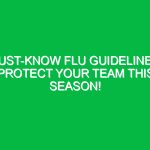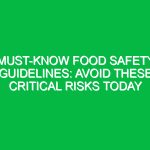“`html
Must-Know Food Allergy Guidelines: Avoid Critical Workplace Risks
Good morning team,
Today, we’re diving into a vital topic that affects not just our health but also our workplace Environment: food allergies. The purpose of this Toolbox Talk is to equip you with the must-know food allergy guidelines that can help us avoid critical risks at work.
Food allergies can be serious and sometimes life-threatening. It’s essential that we all understand how to manage these allergies in our workplace to ensure everyone’s Safety. Let’s get started!
Understanding Must-Know Food Allergy Guidelines
So, what exactly are food allergies? A food allergy occurs when the body’s immune system reacts to specific proteins found in certain foods. This can lead to various symptoms, ranging from mild reactions like hives to severe conditions like anaphylaxis, which can be fatal.
In our workplace, understanding food allergies is crucial because it impacts not only those who suffer from them but also our overall team dynamics and Safety. Common misconceptions include the belief that food allergies are not serious or that they only affect a small number of people. In reality, studies show that food allergies are on the rise, and they can affect anyone at any time.
Key Hazards, Risks, and Safety Considerations
When it comes to food allergies, the risks are significant. Here are a few key Hazards to be aware of:
- Cross-Contamination: This occurs when allergens are transferred from one food item to another, often through shared utensils or cooking surfaces.
- Inadvertent Exposure: Employees may unknowingly consume food containing allergens if ingredients aren’t clearly labeled.
- Emergency Situations: In severe cases, an allergic reaction can lead to anaphylaxis, requiring immediate medical attention.
Ignoring these safety protocols can lead to severe health consequences, not to mention the emotional stress it can cause for both affected individuals and their coworkers. Let’s ensure we stay vigilant and proactive about these risks.
Best Practices, Procedures, & Actionable Advice
Now that we understand the risks, let’s discuss Best Practices to mitigate these hazards. Here’s a step-by-step guide to follow:
- Know the Ingredients: Always read labels and be aware of the common allergens such as peanuts, tree nuts, milk, eggs, wheat, soy, fish, and shellfish.
- Communicate Allergens: If you have a food allergy, communicate it to your team and management. Use clear signage in shared areas to alert others.
- Prevent Cross-Contamination: Use separate utensils, cutting boards, and cooking surfaces for allergen-free meals and those containing allergens.
- Training Sessions: Attend regular Training sessions on food allergy awareness and emergency response Procedures.
- Prepare for Emergencies: Know how to respond if someone has an allergic reaction, including recognizing symptoms and knowing where the nearest EpiPen is stored.
Real-world incidents can highlight the importance of these practices. For example, a workplace that failed to properly label food items experienced a severe allergic reaction when an employee accidentally consumed a dish containing peanuts. This incident not only resulted in a medical emergency but also caused a significant disruption in the workplace.
Regulations, Standards, and Compliance
Compliance with safety Regulations is critical when it comes to managing food allergies effectively. OSHA has guidelines that emphasize the importance of maintaining a safe workplace. Additionally, many organizations have their own internal policies regarding food safety and allergen management.
Understanding and adhering to these regulations is not just about compliance; it’s about fostering a culture of safety. By following these guidelines, we protect our employees and create an inclusive environment for everyone.
Employee Engagement & Discussion
Let’s open the floor for discussion. What safety challenges have you encountered related to food allergies in the workplace? Have you experienced or witnessed an incident that could have been prevented with better knowledge or communication?
Your experiences and insights are invaluable in shaping our safety protocols. Let’s learn from each other and improve our Workplace Safety together.
Conclusion & Key Takeaways
To wrap up, here are the key takeaways regarding food allergy guidelines:
- Understand the seriousness of food allergies and their potential risks.
- Implement best practices to prevent cross-contamination and ensure clear communication.
- Stay informed about regulations and compliance Standards.
- Engage in discussions about safety challenges and solutions.
Prioritizing safety isn’t just a responsibility; it’s a commitment to ourselves and our colleagues. Thank you all for your attention and dedication to maintaining a safe workplace. Let’s continue to look out for one another and prioritize safety every day!
“`


